
Flowers have long been nature’s messengers, carrying profound meanings and sentiments across cultures. Among the most cherished of these messages is the theme of hope. Many flowers can represent optimism, resilience, and the promise of brighter days. But of the countless flowers out there, which of these flowers mean hope? Let’s go over 14 of these beautiful flowers.
1. Forget-Me-Not (Myosotis)

Although commonly connected to symbols of love, forget-me-nots are also symbols of hope and endurance.
©Shulevskyy Volodymyr/Shutterstock.com
The forget-me-not is a short-lived perennial species from the Boraginaceae family. These plants generally showcase petite, five-petaled, primarily blue flowers, although some can be pink or white. Every flower has a yellow center, marking its unique look. Typically measuring about half an inch across, the blossoms often cluster together, creating a lively, blanketed appearance in gardens during their main flowering period.
Forget-me-nots’ connection to hope is profoundly embedded in their name and origins. The moniker of the flower, which earnestly implores “forget me not,” has made it a symbol of lasting memories, perpetual love, and the continual presence of the past in numerous traditions. With its consistent growth in different environments and its tenacious character, the flower symbolizes hope, signifying the continuity of memories and relationships even if they’re out of sight. The recurring bloom of this plant, which reappears even after challenging times, further cements its image as a beacon of hope and steadfast endurance.
2. Iris (Iris)

Coming in many different colors, iris flowers symbolize many things, including intelligence, courage, and, of course, hope.
©Florence-Joseph McGinn/Shutterstock.com
The iris, which belongs to the Iridaceae family, is a perennial bloom in various species and shades. Its unique shape features three petals that face upwards, known as “standards,” and three that face downwards, referred to as “falls.” These flowers display various colors, from blue and purple to yellow, white, and blended shades. Depending on the species and environmental conditions, the height of the iris plants can be anywhere from under 12 inches to several feet, and individual blooms may measure between 2 and 7 inches in diameter.
Historically, the iris symbolizes intelligence, courage, and esteem. It’s mainly associated with hope in certain cultures and traditions. This association with hope is partly because of the iris’s ability to thrive in varied conditions, echoing the enduring nature of hope. The name “iris” comes from the Greek word for rainbow, a symbol often tied to hope and new beginnings. Just as rainbows emerge after a rain, hinting at better times to come, irises bloom regularly, underscoring the enduring presence of hope even in challenging times. The consistent blooming and vibrant appearance make the iris a fitting symbol of hope and a brighter future.
3. Cornflower (Centaurea cyanus)
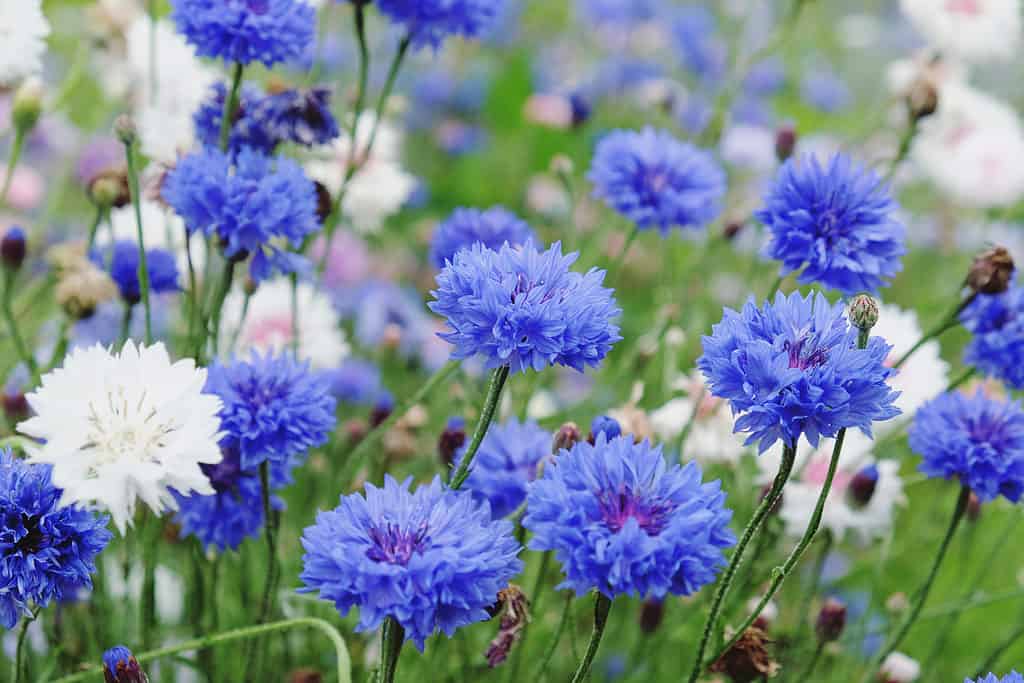
Native to Europe, the cornflower has many symbolic meanings, including clarity, tranquility, and hope.
©Alex Manders/Shutterstock.com
The cornflower is an annual bloom known for its vivid blue petals. Originating from Europe, this plant exhibits a tall and slender frame, often growing to heights between 16 and 36 inches. While blue is the most recognized shade, these flowers can also come in pink, white, and purple hues. Each flower spans about 1 to 1.5 inches, comprising slender, filamentous petals, giving the bloom a frayed look. Historically, these flowers thrived amidst cornfields, which led to their popular name, and their existence recalls an era when fields had richer biodiversity.
Over time, the cornflower has been imbued with different symbolic interpretations. Its radiant blue color, evocative of a serene sky, can signify clarity, tranquility, and hope. In several European customs, wearing cornflowers acted as an amulet to inspire hope of love. Moreover, the cornflower’s ability to prosper brightly within corn fields underscores its representation as hope flourishing against challenges.
4. Star of Bethlehem Flower (Ornithogalum umbellatum)
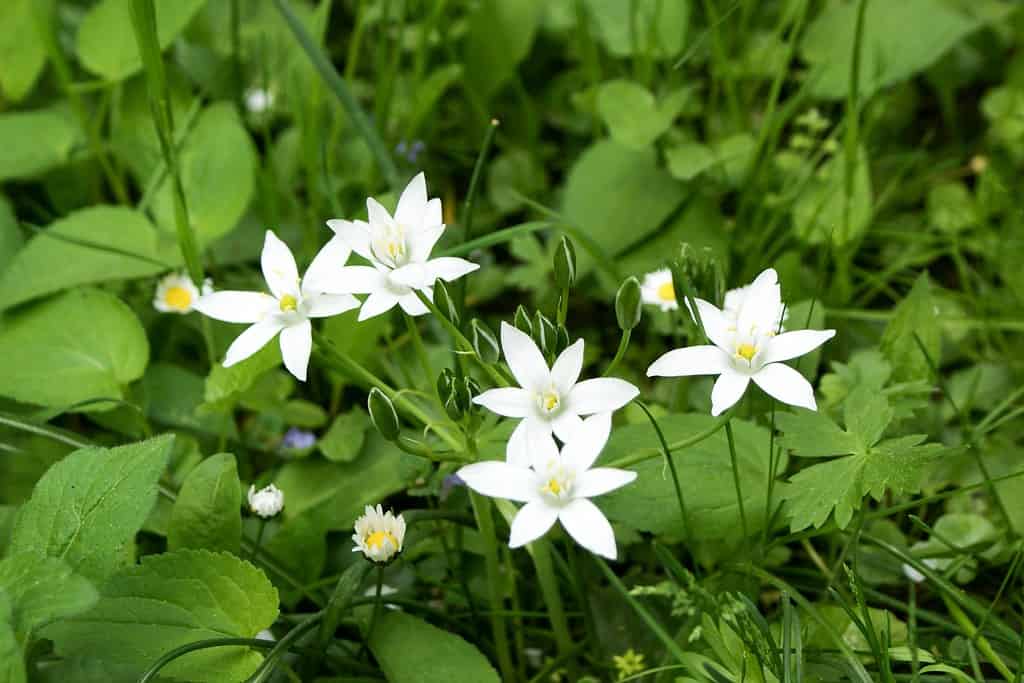
The star of Bethlehem flower represents hope and rejuvenation and is associated with religious stories.
©Joerg-alois/Shutterstock.com
Also known as the Bethlehem flower, the star of Bethlehem is a perennial species that is distinguished by its striking white blossoms that generally flower from late spring to the onset of summer. Each bloom takes on a unique star-like shape, formed by six tepal-like structures spread outwards. The flowers are about an inch in diameter. The plant displays a clump-forming tendency with thin, blade-like foliage, and it can achieve heights ranging from 12 to 19 inches. These elongated leaves frequently exhibit a central white stripe, enhancing their distinct look.
The symbolism of hope attached to the star of Bethlehem stems from religious and historical narratives. Its name is inspired by the ancient city of Bethlehem, as mentioned in the Bible. The flower’s luminous, starry design symbolizes light emerging from darkness, offering guidance and thus epitomizing hope. Over time, because of its connection to the nativity tale and its guiding star, many perceive the star of Bethlehem as an emblem of hope, rejuvenation, and fresh starts. Furthermore, its immaculate white hue underscores sentiments of purity, lucidity, and even enlightenment.
5. Passion Flower (Passiflora)

The passion flower name comes from Christian evangelists who likened the flower to the Passion of Christ.
©Tohuwabohu1976/Shutterstock.com
The passiflora, commonly called the passion flower, belongs to a genus of over 500 species. However, the intricate and distinctive design of its blooms captures widespread admiration. This flower presents a visual spectacle, typically showcasing a round base of five green sepals and five petals that come in purple, pink, or white hues. The diameter of passion flowers varies between 2 and 8 inches, depending on the particular species.
The term “passion flower” originated from Christian evangelists during the 15th and 16th centuries who perceived elements of the Passion of Christ in its intricate floral anatomy, thus associating the bloom with the tale of the crucifixion. The flower’s numerous components were believed to echo various facets of the Passion, encompassing the crown of thorns, the nails, and the disciples. As years passed, the association of the passion flower with the Passion narrative, which pivots around concepts of sacrifice, salvation, and rebirth, intrinsically tied it to the theme of hope. Consequently, the bloom is frequently considered a symbol of religious faith, trials leading to salvation, and the unwavering hope rooted in profound spiritual convictions.
6. Sunflower (Helianthus)

With its vibrant yellow petals, the sunflower stands out as a symbol of hope, trust, and joy.
©Mark Alexander/ via Getty Images
The sunflower stands out with its vibrant yellow petals and a pronounced dark brown or black center. Indigenous to North America, sunflowers possess a fascinating trait: in their early stages, they display something called heliotropism, orienting themselves to follow the sun’s trajectory from the east to the west throughout the day. This is where they get their name! As they mature, sunflowers typically orient towards the east. The size of these flowers can differ widely. While some compact variants achieve heights of just 1 to 2 feet, colossal sunflowers can reach towering heights of over 15 feet, with their blooms spanning roughly 12 inches or more!
Due to their radiant and inviting appearance, sunflowers have historically symbolized hope. Their innate behavior of turning towards the sun, even during gloomier days, represents seeking light and maintaining a positive outlook amidst adversities. Their yellow petals, evoking images of sunlight, further amplify this association, given that the color is commonly tied to feelings of joy, warmth, and hopefulness. Over time, the sunflower’s robust nature and consistent orientation towards brightness have become an enduring symbol of trust, fidelity, and hope for better times ahead.
7. Poppy (Papaver)

The red poppy, in particular, is a token of hope.
©iStock.com/PatrikStedrak
The poppy is a notable plant, distinguished for its vivid and fragile blossoms available in shades like red, orange, yellow, white, and pink. Poppy petals have a characteristic, almost see-through quality that’s reminiscent of tissue paper. Most species of this flower present a single bloom on each stem. The height of these stems can differ across species, though many are typically between 12 to 30 inches tall. At the heart of the bloom, there’s often a pronounced dark mark or a central dark ovary encircled by numerous stamens. Additionally, poppies develop a capsule-shaped fruit packed with minuscule seeds. In certain species, such as the opium poppy (Papaver somniferum), these seeds have culinary and medicinal uses.
Poppies carry many symbolic meanings, but a dominant interpretation, especially concerning the red poppy, is its representation of hope and remembrance. This symbolism gained prominence post World War I when red poppies became tokens of hope, influenced by the sight of these flowers sprouting in war-ravaged terrains. This image underscored themes of endurance and rejuvenation amidst ruin. In current times, the red poppy is a sign of hope and a tribute to individuals who perished in wars.
8. Lotus (Nelumbo nucifera)

Unlike other water lilies, the lotus emerges from the water, making it a symbol of hope, purity, and regeneration.
©iStock.com/Lquang2410
The lotus is a prominent aquatic plant, recognized for its expansive, round leaves and striking blooms. The flower’s petals can be white, various pink hues, and occasionally even yellow or pale blue. Emerging straight from the water, the lotus grows on a stout stem, setting it apart from some water lilies whose flowers lay on the water’s surface. When the lotus blooms fully, it can measure between 8 to 12 inches across. The plant’s sizable leaves, which can spread up to 31 inches, are remarkably able to repel water. This causes water droplets to gather and roll off, a characteristic often referred to as the “lotus effect.”
Across many different cultures, the lotus carries deep symbolic connotations, some of the most celebrated being hope, purity, and regeneration. The growth trajectory of the lotus is noteworthy; it starts its life in muddy pond water and strives upwards, breaking the surface to unfurl its beautiful flower, unsullied by the murky environment it arises from. This journey, from obscurity to illumination, illustrates themes of hope, tenacity, and the potential to triumph over obstacles. The lotus’s ascent from the mud epitomizes emerging from hardships with renewed vigor.
9. Chrysanthemum (Chrysanthemum)
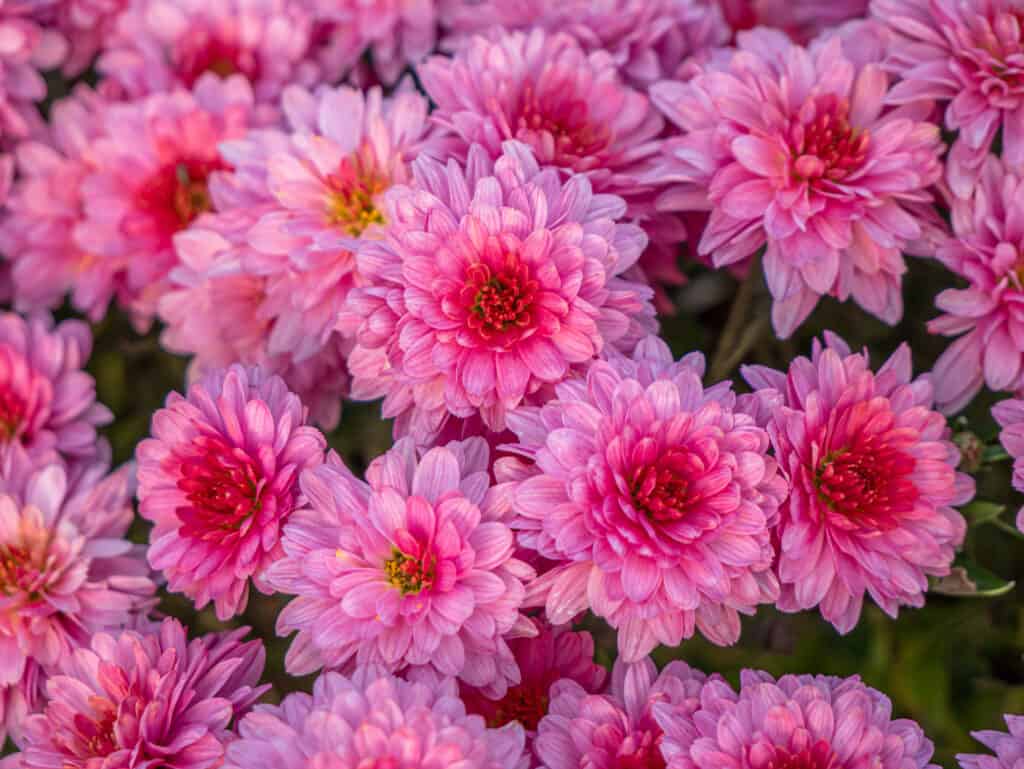
Chrysanthemum blossoms symbolize endurance, rebirth, long life, and hope.
©Volodymyr Yakovyna/Shutterstock.com
Hailing from Asia, chrysanthemums captivate with their multi-layered petal designs. Their looks vary from the simplicity of daisies to intricate spider and pompon patterns. They display a spectrum of colors, ranging from soft whites and vivid yellows to gentle pinks and rich reds, purples, and bronzes. The size of their flowers can be as petite as 1-3 inches or as grand as 5-6 inches, depending on the species. Some are perfect for container gardening, while others rise tall in gardens.
Historically, chrysanthemums have symbolized endurance, rebirth, and long life. Their blossoms, persisting into the colder months, represent perseverance and a beacon of hope amidst adversities. Particularly in East Asian cultures, their affiliation with the fall months underscores sentiments of happiness, the richness of life experiences, and optimism.
10. Daffodil (Narcissus)
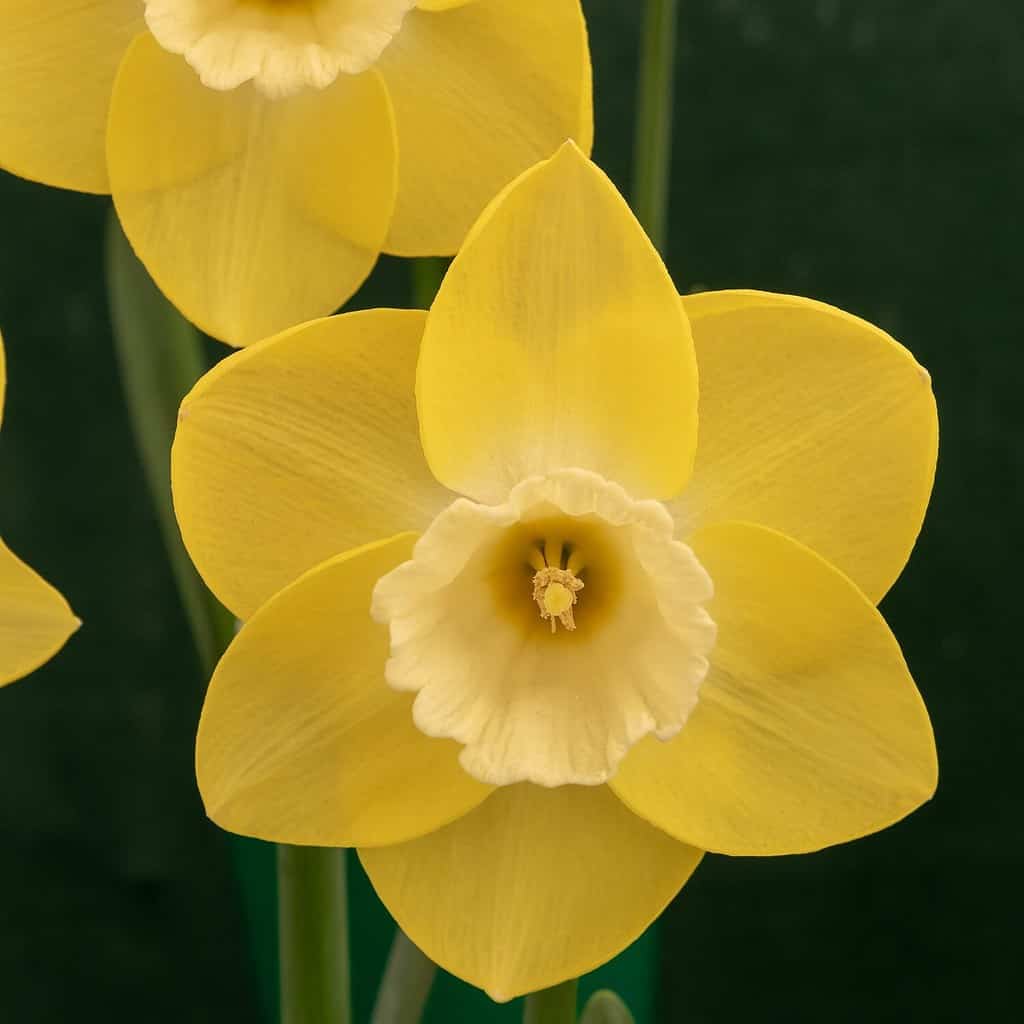
While the yellow daffodil is the most iconic, these flowers also come in hues of white, orange, and pink.
©Joe Kuis/Shutterstock.com
Originating from the woodlands and meadows of southern Europe and North Africa, daffodils stand as perennial favorites known for their vibrant allure. While yellow remains their most iconic hue, these flowers are also found in shades of white, orange, and occasionally pink. A standard daffodil bloom spans between 1.5 to 2.5 inches in diameter, with the plants’ heights varying from 12 to 18 inches, influenced by their variety and habitat.
For generations, daffodils have symbolized hope and renewal. Emerging at spring’s onset, they symbolize the end of winter and the beginning of lovely sunnier days. Across diverse cultures, the flower’s radiant color represents hope and heralds new beginnings. Prestigious organizations, like the American Cancer Society, recognize the daffodil as a beacon of hope, visualizing a world less burdened by diseases like cancer. As they flower in spring, a season associated with rejuvenation, daffodils echo themes of positive transformation and new life.
11. Yellow Tulip (Tulipa altaica)
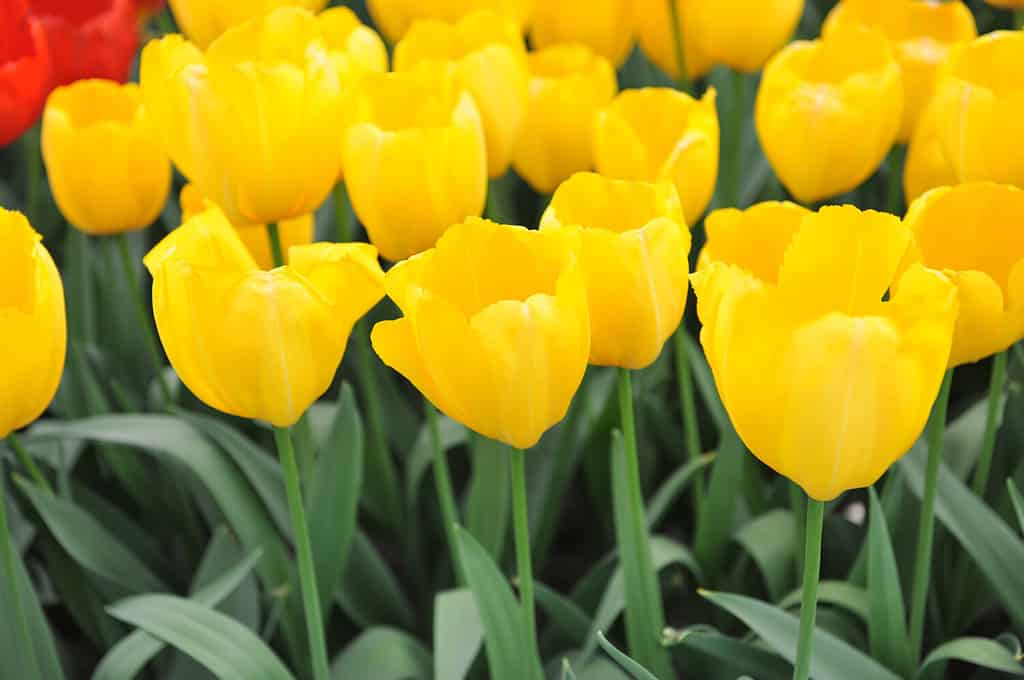
Yellow tulips embody cheerfulness, joy, vigor, rejuvenation, and hope.
©Sergey V Kalyakin/Shutterstock.com
Originating from the Tulipa genus, yellow tulips are lively spring perennials recognized for their radiant flowers. Their distinct cup-like blooms rise on robust, individual stems. Typically, these blossoms measure between 2 to 3 inches, though variations can occur depending on the cultivar. With a gentle inward curve at the ends, their expansive petals are set off by sharp, green leaves, adding to the flower’s visual allure.
Ranging in hues from soft lemon to rich gold, yellow tulips cater to a spectrum of tastes. Their historical significance is highlighted by events such as the 17th-century Dutch “Tulip Mania”, attesting to their enduring appeal. Among the myriad tulip colors, yellow variants are especially famous for their embodiment of cheerfulness and hope. Their luminous shade inspires sentiments of joy, vigor, and rejuvenation as well. Emerging after the winter months, these flowers symbolize the forthcoming warmth and brightness. Due to this representation, yellow tulips have become popular for celebrating fresh starts, achievements, and optimistic pursuits.
12. Bluebell (Hyacinthoides non-scripta)

Blooming from April to May, bluebells are perennials that symbolize hope, humility, and appreciation.
©iStock.com/Mike_Colwill
Bluebells are perennials that have characteristic bell-formed blossoms. While they are most commonly adorned in deep blue shades, as evidenced by their name, there are also variations in white and pink hues. These flowers have roots in Western Europe and are especially prevalent in the British Isles. Each stem can bear up to 20 hanging flowers, measuring around 1 inch in length. The vibrant green, lanceolate leaves can stretch from 12 to 16 inches, providing a gorgeous contrast to the flowers.
Bluebells are synonymous with woodlands and thrive best in moist, shaded forests. Their peak blooming season spans April to May, during which woodlands are blanketed in a cerulean hue, capturing the essence of a British spring. Beyond their beauty, bluebells help contribute to the ecosystem, offering early-season nectar to bees, butterflies, and various insects.
While bluebells are undeniably a gorgeous sight, they also carry weight in meaning. Historically linked to notions of humility and appreciation, their annual reemergence post-winter also aligns them as symbols of endurance, renewal, and optimism.
13. Snowdrop (Galanthus nivalis)
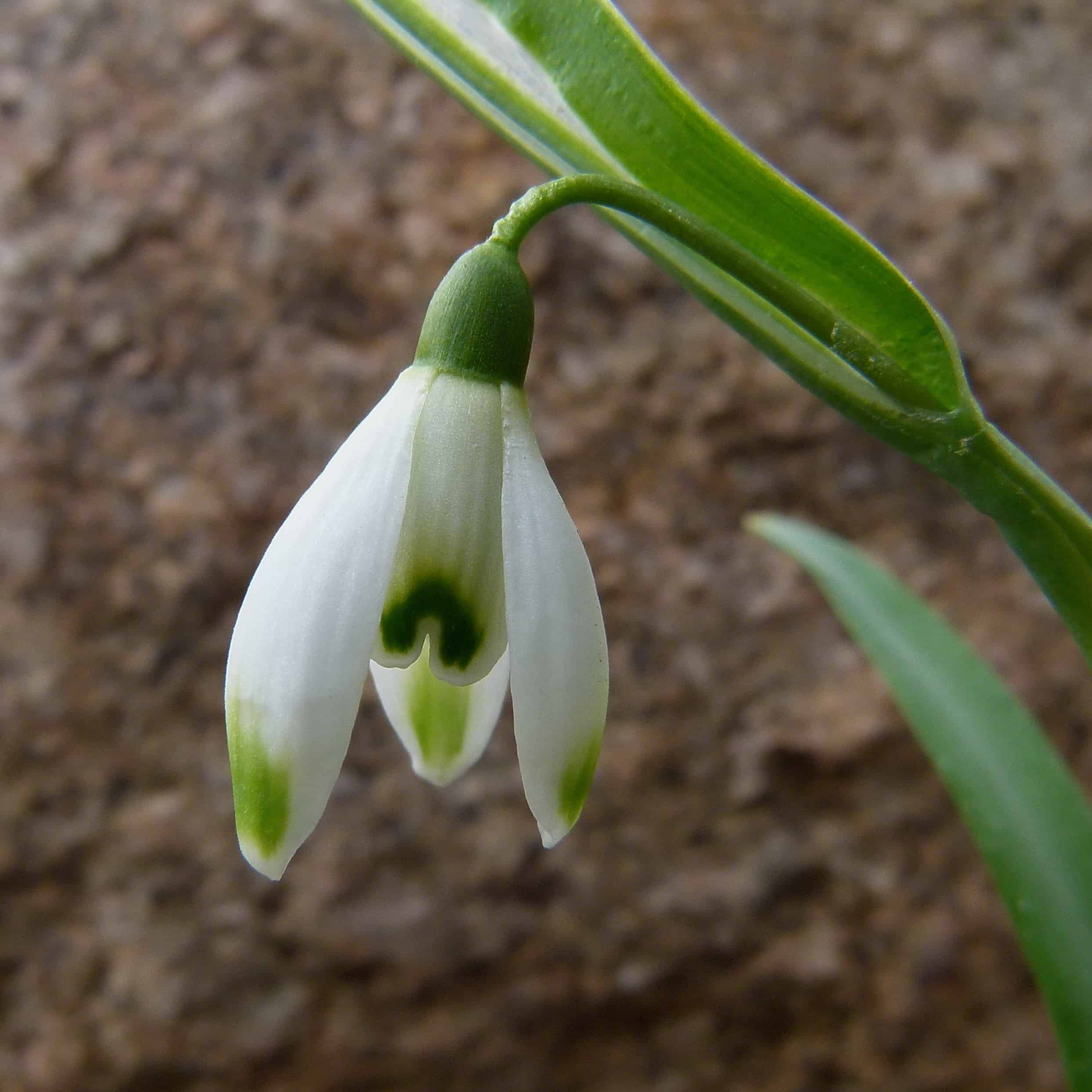
A perennial plant, the snowdrop is a symbol of hope as it emerges in the wintertime.
©
The snowdrop is a small perennial plant characterized by its white, hanging blossoms that appear from late winter to the onset of spring. Often among the first to flower after winter, they sometimes push through snow, showcasing their pristine petals. A typical snowdrop flower features three larger outer petals and three inner ones with a green tip. Its narrow, vibrant green leaves contrast sharply against the often snowy ground from which they emerge. A mature snowdrop plant stands anywhere from 3 to 10 inches tall, making it a subtle highlight in gardens and woodlands.
Snowdrops are revered as symbols of hope due to their timely appearance. Blooming in the wintertime, they signify the forthcoming warmth of spring. Their resilience in the cold and role as early indicators of a changing season underline their ties to renewal and a brighter outlook. Moreover, the snowdrop’s act of breaking through the snow to bloom speaks of persistence and strength. Consequently, many cultures cherish the snowdrop as a symbol of hope and the expectation of brighter times ahead.
14. Morning Glory (Ipomoea)
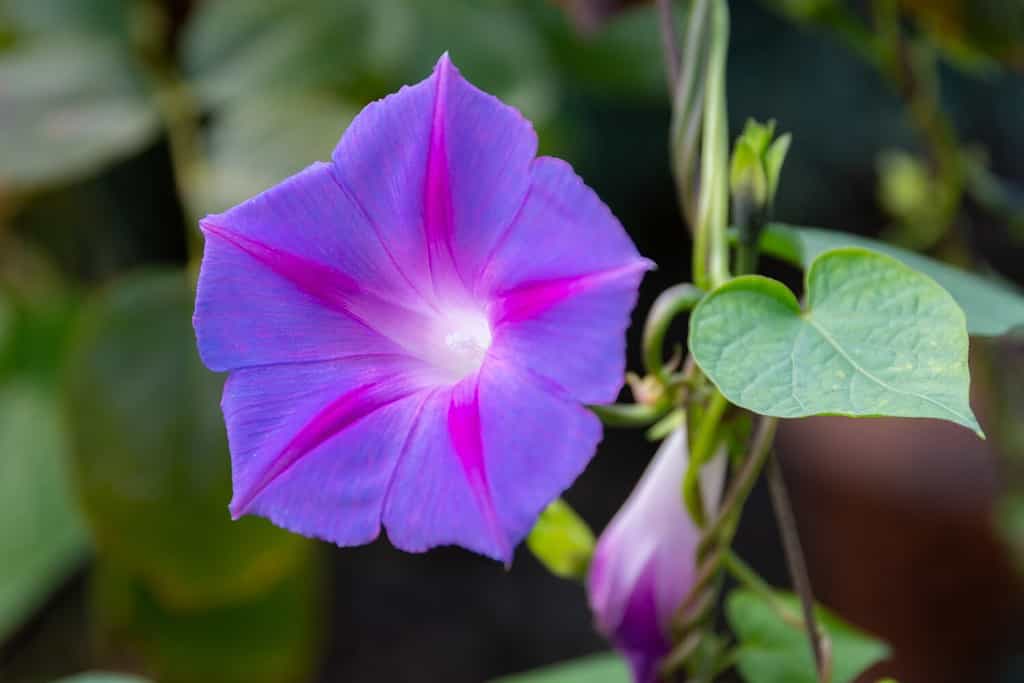
The morning glory symbolizes hope as it is able to survive in adverse conditions.
©CoinUp/Shutterstock.com
The final flower on our list of gorgeous flowers that mean hope is the morning glory. The morning glory is a delicate flower with beautiful, vibrantly-colored blooms, ranging from red, pink, purple, blue, and white. Some varieties even unfurl bicolor blooms. The blooms range in size from 2 to 3 inches across. As the flower’s name may suggest, the flower is associated with the morning; it blooms very early in the day and fades by the afternoon. This reminds us that every day is a new beginning.
Many use the morning glory flower to symbolize and represent hope, thanks to its ability to survive in adverse conditions, including harsh weather and poor soil. Surviving even the harshest of conditions, the morning glory still manages to grow and thrive, showcasing its colorful blooms. For this reason, the morning glory flower is also used to symbolize strength and perseverance.
Summary of 14 Gorgeous Flowers That Mean Hope
| Number | Flower | Botanical Name | Symbolism |
|---|---|---|---|
| 1 | Forget-me-not | Myosotis | True love, remembrance, devotion, loyalty, and hope |
| 2 | Iris | Iris | Wisdom, trust, royalty, intelligence, courage, and hope |
| 3 | Cornflower | Centaurea cyanus | Love, fertility, unity, the future, anticipation, devotion, fidelity, prosperity, wealth, and hope |
| 4 | Star of Bethlehem flower | Ornithogalum umbellatum | Jesus, innocence, honesty, forgiveness, and hope |
| 5 | Passion flower | Passiflora | Jesus, strength, purity, and hope |
| 6 | Sunflower | Helianthus | Long life, happiness, trust, fidelity, and hope |
| 7 | Poppy | Papaver | Sleep, peace, death, rebirth, remembrance, and hope |
| 8 | Lotus | Nelumbo nucifera | Purity, rebirth, strength, and hope |
| 9 | Chrysanthemum | Chrysanthemum | Happiness, the richness of life experiences, optimism, perseverance, and hope |
| 10 | Daffodil | Narcissus | Renewal and hope |
| 11 | Yellow tulip | Tulipa altaica | Energy, strength, growth, cheerfulness, and hope |
| 12 | Bluebell | Hyacinthoides non-scripta | Humility, constancy, gratitude, everlasting love, and hope |
| 13 | Snowdrop | Galanthus nivalis | New beginnings and hope |
| 14 | Morning glory | Ipomoea | Innocence, love, and hope |
Thank you for reading! Have some feedback for us? Contact the AZ Animals editorial team.








